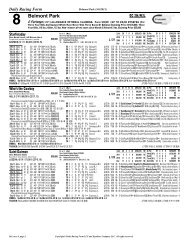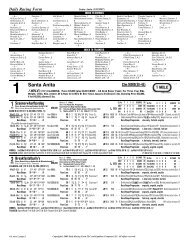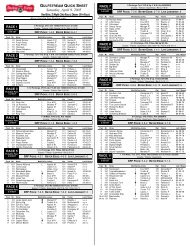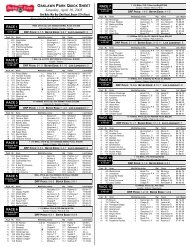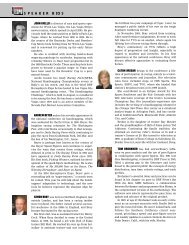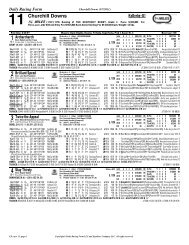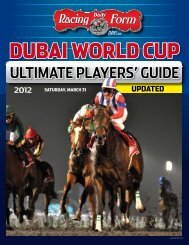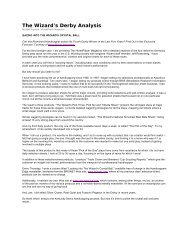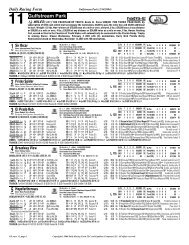BreezeFigs Special Report
BreezeFigs⢠Special Report - Daily Racing Form
BreezeFigs⢠Special Report - Daily Racing Form
Create successful ePaper yourself
Turn your PDF publications into a flip-book with our unique Google optimized e-Paper software.
<strong>BreezeFigs</strong> <strong>Special</strong> <strong>Report</strong>How to Prepare for the 2005 2-Year-Old Racing SeasonBased on ROI Results From The “Class of 2004”In our <strong>BreezeFigs</strong> introduction, we explained all the basic factors that you need to keepin mind when it comes time to bet 2-year-old races that have one or more “graduates” ofprominent 2-year-olds-in-training sales.Now we are going to give you some advice for maximizing your Return on Investment(ROI) when you play maiden races for graduates of the 2005 sales, i.e., 2-year-olds of 2005 and3-year-olds of 2006 (we discontinue providing <strong>BreezeFigs</strong> for 3-year-olds on July 1 st ).The advice is based on an exhaustive study of the past performances of more than 1,500horses that came out of seven major sales for 2-year-olds in 2004 for which we have at least oneBreezeFig, and who also started at least once in 2004 or 2005 at a track in North America orPuerto Rico.These horses have become increasingly important for handicapping purposes in thepast few years—more horses are sold at these sales than ever before, and a higherpercentage of very good horses, and horses that win early, are coming out of these salesthan ever before. Want proof?Take the first four finishers in the 2005 Kentucky Derby and Preakness, look at wherethey came from: Giacomo never went through a sale, but Afleet Alex, Closing Argument, Don’tGet Mad, Scrappy T. and Sun King were sold at public auction. Sun King was sold as aweanling, and the other four were sold at 2-year-old sales. The first three broke their maidens intheir first starts, Scrappy T. in his second. All of them were eminently qualified Group 1 orGroup 2 horses on <strong>BreezeFigs</strong> and if you’d bet each of them through their winning start,your ROI would have been $6.78.Our purpose is to make sure you find these horses and that you strongly consider usingothers like them that are likely to produce a strong ROI in certain situations. We will also tellyou what kind of horses to stay away from under any circumstance—that could add up tomore than 40% of the horses you will see on our <strong>BreezeFigs</strong> lists.We will focus on what BreezeFig Groups at which sales produce best ROI results, whatsales overall produce best results, and how much attention you should pay to horses that arelisted as RNA or SCRATCHED in our reports.We will also give you a complete case history of how <strong>BreezeFigs</strong> worked for every raceat the 2004 Saratoga meet. Having studied this market since 2001, we are confident that as thecurrent 2-year-old season heats up, this advice can help you handicap better and generate astrong rate of return.Our ROI study is based on the following premise: If you bet every horse in a certaincategory to win for its first two starts, what is the ROI? This means that if a horse wins its firststart, your bet was $2.00 on that horse (we do not count the next race if you bet him back for thisstudy); if a horse loses its first start, we also bet its second—if it wins the second race, or neitherrace, the bet is $4.00.We’ll give you this advice in a simple Q&A format. If you don’t want to read it all, goto the last page for a quick synopsis of the best ROI bets.
Q: Why do I get <strong>BreezeFigs</strong> for horses making their third or fourth start?<strong>BreezeFigs</strong> are provided for horses through their fourth career start for two reasons. 1)To accommodate customers who have just subscribed and may have missed previous <strong>BreezeFigs</strong>reports, and 2) So the handicapper can see whether a horse that had a good BreezeFig at a goodsale has lived up to expectations, or whether a horse that had a moderate BreezeFig at a moderatesale may be actually better than it appeared to be at the sale.Q: So, I should take <strong>BreezeFigs</strong> into consideration for each of a horse’s starts, even if itwins its first or second race?We do not recommend betting horses based on their <strong>BreezeFigs</strong> alone after the secondstart. That’s because by then, real ability, Beyer numbers, training regimens, and racing luckshould have played into some reasonable form for each horse.<strong>BreezeFigs</strong> are there for guidance in situations where they might be useful—e.g., a horsemaking its third start with a good BreezeFig from FTFFEB meets a horse making its first startfrom the same sale with a similar BreezeFig—you might be able to extrapolate form for the newhorse better.Or if a horse earned a Group 1 BreezeFig at OBSMAR and has finished off the board inits first two starts in maiden special races in New York and then moves to maiden special atPhiladelphia for its third start, that BreezeFig may be important to reconsider as a positivebecause the competition is probably weaker. On the other hand, if that Group 1 horse began itscareer in maiden claimers at Belmont Park, you might want to pass his first race by just to see ifhe’s capable of running at all.Q: What should I do if a horse has two <strong>BreezeFigs</strong> at the same sale?You’ll see this in two circumstances: If a horse worked two separate distances, it wouldhave two <strong>BreezeFigs</strong>. Similarly, a horse could have <strong>BreezeFigs</strong> for two different sales (somehorses that are not sold early in the year come back in another sale in the Spring). In both cases,eliminate the lower BreezeFig.For example, if a horse is Group 2 at 1/8 of a mile and Group 3 at a quarter mile from thesame sale, eliminate the latter. If a horse is in the same Group for both distances at the samesale, use the BreezeFig that is the highest relative to Par for that distance (subtract Par from thehorse’s BreezeFig—if you get a negative result, see below). You are looking for the best possibleperformance by a horse so that you know its best potential.Q: O.K., what if I get a negative number when I subtract Par from a horse’s BreezeFig?You will get a negative number if a horse worked one point or more below Par for thatdistance and sale (e.g., BreezeFig = 60, Par = 63, negative = 3). No matter if a horse has one ortwo <strong>BreezeFigs</strong> don’t bet that horse to win unless its best BreezeFig is no lower than two pointsunder Par for that sale. You may want to use the horse in gimmicks, but be careful. Here’swhy: Through June 1, 2005, at the top of the breed, 19 Graded stakes winners that came out of 2-year-old sales in 2004. Fifteen (79%) were Group1 or Group 2 <strong>BreezeFigs</strong> horses. Of the 55<strong>BreezeFigs</strong> horses that won non-Graded stakes, 40 were Group 1 or Group 2 horses, and anothereight had <strong>BreezeFigs</strong> within 2 points below Par. That means 74% of the good horses wereGroup 1 or Group 2, and 85% of them earned a BreezeFig no lower than two points below Par.
Q: So what. I’m not looking just for horses that are going to be stakes winners. I amlooking for winners, period.Of the stakes winners, 52 (70%) broke their maidens in their first or second starts. Thiswas a similar at all class levels down the line—the higher the BreezeFig, the better thechance of a return early. Here are the stats for a full year of racing for the “Class of 2004.”• 41.3% of all Group 1 and Group 2 starters from all sales win in their first two starts.• 12.3% of other starters with <strong>BreezeFigs</strong> at 1 or 2 below Par win in their first twostarts.Unless you have spectacular inside information about a horse, try to avoid playinghorses that are 3-below-Par or worse in Group 3 or Group 4 in their first two starts unlessthey are in bottom-level maidens at second or third level tracks.Important: It makes no difference if you are betting <strong>BreezeFigs</strong> horses in June of their2-year-old year or in April of their 3-year-old year. Here is a compilation of all the races forcurrent 2-year-olds (graduates of 2005 sales) at every track in the country June 1-23, 2005:Level Starters Winners Total Bet ROIGroup 1 34 17 68.00 2.16Group 2 106 24 212.00 0.94Group 3 33 8 66.00 0.92Group 4 34 7 34 0.52Note: Stats are only through a horse’s first two starts, only first start if a horse breaks itsmaiden in its debut. Therefore, no stakes races are included because all the horses that ran inthose races had already broken their maidens (the ROI would be higher, by the way). 90% of thewinners in Group 3 were within 2 points of Par. All of the winners in Group 4 were below thatlevel. While the ROI numbers may seem weak for Group 2, remember, this is for every race runin the country and in eight of those races, Group 2 horses were part of the exacta under either aGroup 1 horse or another Group 2 horse.Here’s how it looks if you bet every Group 1, Group 2 and Par-qualified horse in every 2-year-old race through June 23, 2005 on the five major circuits in the country (yes, 8-of-9 winnersat NYRA and almost half at Calder).All StartersCircuit Starters Races Winners Win OnlyFlorida 78 35 17 1.25NYRA 20 9 8 2.07Los Angeles 24 13 5 0.59Kentucky 43 23 10 0.44Midlantic 28 16 9 1.17Note: Virtually all the Santa Anita-Hollywood winners were odds-on and they beat otherGroup 1 or Group 2 winners. The ROI on Kentucky Group 1 bets is $2.06.
Q: That’s all well and good, but what was the ROI record for the Class of 2004 on first andsecond starts?If you bet every Group 1 or Group 2, or Par-qualified Group 3 or Group 4 horse at everytrack across the country from the Class of 2004 for its first two starts, you would be broke today.Some of these horses come out of the sales with physical problems from which they never fullyrecover while others are too ambitiously placed by their connections who paid too much for themat a sale but are trying to maintain their market value.The best way to approach this question is on a sale-by-sale basis, and also to isolateparticular race meetings for any insights. Here is a compilation of the seven sales we followed interms of winners they produced, listed in the order of the month in which the sale is held (Group1 and Group 2 figures are much better, but we give you all the horses for perspective):Total in Number of % Starters Percentage of Winners to StartersSale The Sale Starters From Sale All Winners 1st Time 2nd Time 1st + 2ndOBSFEB 137 103 75.2% 43.7% 19.4% 3.9% 23.3%FTFFEB 207 128 61.8% 42.2% 8.6% 6.3% 14.8%BARMAR 113 75 66.4% 28.0% 9.3% 4.0% 13.3%OBSMAR 363 249 68.6% 50.6% 15.7% 6.4% 22.1%KEEAPR 168 102 60.7% 35.3% 4.9% 6.9% 11.8%OBSAPR 883 614 69.5% 51.3% 8.6% 7.3% 16.0%EASMAY 416 286 68.8% 41.6% 11.2% 8.4% 19.6%Total 2287 1557 68.1% 46.0% 10.7% 6.9% 17.6%Now, let’s get a bit more particular by looking at each sale and how they can best beplayed at the windows.OBSFEB: The Ocala Breeders Select sale at Calder Race Course in Miami leads off theparade in early February. Theoretically, that means these horses are likely to get to the racesearlier than those from other sales, and they do—of the 93 horses from the 2005 sales that startedthrough June 1 st , 36 of them (39%) came out of this sale. They tend to have a lot of speed—mostof them breeze only 1/8 of a mile at this sale. This sale also has the fewest horses of all themajor East Coast sales, but the percentage of ones that get to the races is the highest, and moreimportantly, the percent that win their first start is by far the best of the group, and the combinedpercentage of first and second time start winners is also the best, but not by much.FTFFEB: About a month after OBSFEB, the Fasig-Tipton Select sale is held at Calder.This sale usually has twice as many horses in it, and the pedigrees are much more glamorousthan any sale except possibly for Keeneland’s April sale—as such, it generally produces worldrecordprices and very high sales averages.This sale has had a very good record over the past half-dozen years for producing topqualityhorses. But it also has a very spotty record of producing a consistent number of first orsecond time winners—many of those high-priced horses don’t stand up to the wear and tear ofgetting to the races early, let alone winning. The people who come to sell horses at this sale areclearly looking for the home run—in 2004, four sold for more than $1 million, with the toppriced horse at $4.4 million. Two of the four have yet to get to the races, and only one has won—his only start to date.
The 2005 sale was the second time the company was able to allow some horses to breezeon the turf—there were not many, but you would be wise to pay attention to these horses if theycome out in a turf race, especially if they have <strong>BreezeFigs</strong> for both dirt and turf. The turf figs arelikely to be much higher—they may be worth a bet, though we have no history to provide.What this sale does produce in buckets is horses that do not meet their reserves at thesales (RNA), which is the price at which the owner is willing to sell. Ironically, this sets up avery decent wagering proposition from our point of view. Here is a table showing the success atthe track of horses that were RNA at each sale.Starters Starters Number of Percentage of RNA Winners to RNA StartersSaleFrom Sale RNA at Sale RNA Wnrs All Winners 1st Time 2nd Time 1st + 2ndOBSFEB 103 24 14 58.3% 28.6% 14.3% 42.9%FTFFEB 132 45 20 44.4% 45.0% 15.0% 60.0%BARMAR 73 24 6 25.0% 33.3% 33.3% 66.7%OBSMAR 248 75 34 45.3% 32.4% 14.7% 47.1%KEEAPR 102 42 13 31.0% 15.4% 7.7% 23.1%OBSAPR 612 129 74 57.4% 14.9% 17.6% 32.4%EASMAY 297 72 30 41.7% 10.0% 20.0% 30.0%Total 1332 342 157 45.9% 18.5% 17.2% 35.7%While OBSFEB has a higher percentage of RNA winners overall, it’s FTFFEB thatclearly has a higher early strike rate. This pattern holds true for horses that are noted in oursheets as SCRATCHED from the sale, which means that they breezed at least once and thenwere not sent through the ring. The reasons range from the fact that they either hurt themselvesslightly in their breeze, or got sick after it, or their owners panicked that the sale would be badand decided to keep them. In any case, you should look at RNA and SCRATCHED horses thesame way.BARMAR: The premiere 2-year-old sale on the West Coast, Barretts Select sale inMarch is the most unusual because its breeze shows are at Fairplex Park, a 5/8-mile bullring thatis lightning fast, producing fast times and sometimes extraordinary <strong>BreezeFigs</strong>. This isespecially true for horses that breeze a quarter mile because the finish line is not at the wire—it’son the clubhouse turn. Thus, horses are being pushed to the limit to accelerate through thestretch and make it around the turn faster—the result is that many of them simply never run backto that work.This sale attracts some very high-class pedigreed runners, many prepared in Florida andthen shipped to Los Angeles, primarily for the edification of the high-end California stables aswell as for customers from Japan. It has had a spotty record of producing excellent horses(Unbridled’s Song came out of this sale, but even he was a problem—he was returned by theJapanese buyer after the sale because of a minor injury).Barretts has had a very spotty record for handicappers as well—because they aredominant in 2-year-old races in California early vs. horses that are being sent from the EastCoast sales to race in the state, they are often the only sales horses in the early races, and are overbet. Also, when they race outside of California, the mystique of this sale carries over to thewindows. This year, for example, 13 of the first 93 starters in all 2-year-old races came out ofthe 2005 Barretts sale—five of them won (four first time starters) which is very healthy.
OBSMAR & OBSAPR: Improving with quality every year, the Ocala Breeders Marchsale and the Ocala Breeders April sale attract the widest cross-section of buyers from across thecountry. They are also the toughest sales for producing a consistent ROI in any category becausemany of the horses that are sold for very little money (below $20,000) simply have very littletalent and are usually placed too high in their first two or three races.Generally speaking, horses that are sold for more than $50,000 at either sale arereasonable bets at top tracks in most maiden races, especially if used in gimmicks. Both salesproduce more than their share of winners at Calder in the summer and fall, and OBSAPR has avery high profile in Puerto Rico. As the RNA chart above shows, OBSMAR has a very goodrecord for sending out early winners that were not sold at the sale.KEEAPR: With the “best catalogue on paper” each year, Keeneland’s April sale attractsthe world’s toniest players because it comes during the track’s Spring meet, on Blue GrassStakes weekend. They spend a lot of money for horses that breeze very fast and look beautiful,but only 12 of the 102 starters broke their maidens in their first two starts from the 2004 sale—aterrible betting proposition. This sale, however, is best known for having pioneered breezes onthe turf. In 2004, the turf breeze show was cancelled because of a violent storm, but previousyears’ results indicate that the best play to consider as a handicapper in this sale is a horse with avery good turf BreezeFig in a race at a track with a lightning fast turf course.EASMAY: Better known as the Fasig-Tipton Midlantic sale, this one is held atPreakness time at Timonium Racetrack, a 5/8 mile track outside of Baltimore, where Afleet Alexwas a Group 1 horse and sold for $75,000 in 2004 off a quarter-mile BreezeFig of 63 against aPar of 58. He is not an aberration.This sale is a handicapper’s dream in many respects because the people who buy horseshere often do not attend other sales, but they have to win races, and they spot their purchaseswell. However, beware—there are also more cheap horses here per capita than most other sales,and those that are sold cheaply, even if they have good <strong>BreezeFigs</strong>, should not be primecandidates for your dollars at major racetracks except in state-bred competition. Still, you canbet on these horses in their first two starts, all things considered, with some confidence.* * * *On the next page is our analysis for Saratoga.
How to Use <strong>BreezeFigs</strong> at SaratogaIf you believe that statistics point out consistency in form, then you will gain a great dealof insight in simply absorbing what happened at Saratoga in 2004 when it came to using<strong>BreezeFigs</strong> to help handicap races for 2-year-olds.Here is a synopsis of the horses that raced at Saratoga at two last year after earning<strong>BreezeFigs</strong> at the 2004 2-year-old sales.Number of races for 2-year-olds 64Races won by <strong>BreezeFigs</strong> Horses 27Here is the way the <strong>BreezeFigs</strong> horses performed by <strong>BreezeFigs</strong> Group:Total <strong>BreezeFigs</strong> Starters 178Group 1Starters 66Wins 9Seconds 16Thirds 25Group 2Starters 57Wins 13Seconds 20Thirds 28Group 3Starters 37Wins 4Seconds 8Thirds 9Group 4Starters 18Wins 1Seconds 1Thirds 3The next table is split into two parts: The YELLOW shaded part on the left shows howALL <strong>BreezeFigs</strong> horses performed (it shows that <strong>BreezeFigs</strong> horses started in 59 of the 64 racesand won 27 of them), including both stakes in which they started (thank you, Afleet Alex). TheBLUE shaded part shows the ROI for Win only, W-P-S, and Exacta wagers if you bet everyGroup 1 and Group 2 horse in every race in which they ran, regardless of their previousform, if any, regardless of their odds, regardless of what you thought of their chances.
Type of Race Number of Races % Races ROI on ALL G1 & G2 ONLYBy Type BF Rnrs BF Wnrs Won by BF Win W-P-S ExactaGrade 1 & Grade 2 4 2 2 100% 1.14 0.33 2.95Maiden <strong>Special</strong> Dirt Open 25 25 11 44% 0.81 0.99 1.75Maiden <strong>Special</strong> Turf Open 7 7 1 14% 0.00 0.00 0.00Non-Winners 1x Open & NY-Bred 5 4 1 25% 0.19 0.37 4.98Maiden <strong>Special</strong> NY-Bred 15 15 7 47% 1.46 1.82 17.38Maiden Claimer 50g-75g 8 6 5 83% 1.36 1.14 5.58NOTE: The huge Exacta ROI was attributable to a $2,069.00 exacta with Accurate and NaughtyNew Yorker in a New York-Bred Maiden <strong>Special</strong>. The Trifecta in the race was over $17,000,with the third horse a <strong>BreezeFigs</strong> Group 1, Thunderprince, the favorite in the race.Saratoga is a special meeting in some people’s minds, but it is very consistent from ahandicapper’s point of view. The results of this survey show that betting Group 1 andGroup 2 horses in New York-Bred races and maiden claiming races is especiallylucrative—a pattern which holds true all year long. There would have been better ROI’s ifwe had included some Group 3 and Group 4 horses whose <strong>BreezeFigs</strong> were within 2 points ofPar, but that would have complicated matters. By reducing the number of potential bets, weincreased the odds against <strong>BreezeFigs</strong> horses. Still, they came through in the exactas and inrestricted company. If you pick your spots carefully, you can achieve far better results.* * * *



